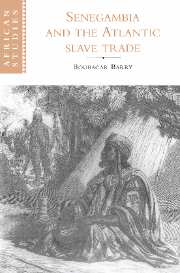Book contents
- Frontmatter
- Contents
- Preface
- Map
- I Senegambia from the fifteenth to the seventeenth century: a haven for incoming populations, a station for migrants on the move
- II Senegambia in the eighteenth century: the slave trade, ceddo regimes and Muslim revolutions
- III Senegambia in the first half of the nineteenth century: legitimate trade and sovereignty disputes
- IV Senegambia in the second half of the nineteenth century: colonial conquest and resistance movements
- Conclusion
- Notes
- Bibliography
- Index
- Other books in the series
II - Senegambia in the eighteenth century: the slave trade, ceddo regimes and Muslim revolutions
Published online by Cambridge University Press: 31 October 2009
- Frontmatter
- Contents
- Preface
- Map
- I Senegambia from the fifteenth to the seventeenth century: a haven for incoming populations, a station for migrants on the move
- II Senegambia in the eighteenth century: the slave trade, ceddo regimes and Muslim revolutions
- III Senegambia in the first half of the nineteenth century: legitimate trade and sovereignty disputes
- IV Senegambia in the second half of the nineteenth century: colonial conquest and resistance movements
- Conclusion
- Notes
- Bibliography
- Index
- Other books in the series
Summary
Beginning in the second half of the seventeenth century, the development of sugar cane, cotton, and tobacco plantations in the New World led to an expansion of the slave trade. So from the eighteenth century to the first half of the nineteenth, slave trading became the center of Europe's trade with Africa. To use Samir Amin's expression, America became the European periphery, and Africa became the periphery of the American periphery. In this slaving era, the continent of Africa went through “one of the most massive processes of human transportation ever to have taken place by sea.” Throughout the fifteenth, sixteenth and part of the seventeenth centuries, Senegambia had been the main source of slaves. After that, it was superseded by other regions, especially the Gulf of Guinea and Angola. Still, on account of its geographical position, Senegambia continued to supply the sugar-growing islands on a permanent basis.
Senegambia, conquered by the Portuguese, the French, the Dutch, and the British, expanded eastward toward the Sudan and northward toward Mauritania, thus bringing the Bambara states of the Niger Bend and the Moorish emirates of Chamama into the orbit of the Atlantic trade.
- Type
- Chapter
- Information
- Senegambia and the Atlantic Slave Trade , pp. 55 - 60Publisher: Cambridge University PressPrint publication year: 1997

